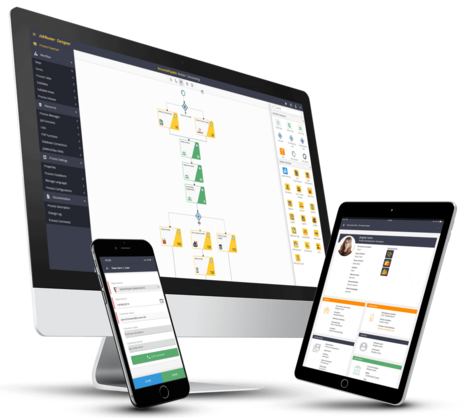
Low-code vs. No-code Development
- Last updated , created on
- Reading time
No-code vs. low-code is one of the leading market trends. Find out here what companies hope to achieve, what exactly low-code and no-code means and what the differences are between these two software development approaches.
Meaning
How are low-code and no-code defined?
By definition, low-code and no-code are two different approaches that enable non-professional developers to write their own applications or programs. However, the level of expertise between developers in each group can vary significantly.
What is low-code development?
Low-code development means involving technically experienced users in programming via a visual development approach. The proportion of manual coding is low and represents 20:80 of the configured code. “Low” in this case indicates the low level of effort required. When it comes to “hard coding”, however, professional programmers are required to support citizen developers and low-code developers.
What does no-code mean?
No-code is a form of development where users do not need any programming skills. No-code platforms can therefore be used by citizen developers to program. For example, employees can drag and drop the required components into the process graphic and connect them. They can configure and develop software applications without writing a single line of code, using a library of functions.
Advantages
Why is low-code and no-code development important?
The advantage of low-code and no-code is that the effort required to configure and maintain the infrastructure is reduced. This helps companies with digital transformation, aids in the fight against skills shortages and provides competitive advantages, as you will read below.
Low-code no-code - fighting the shortage of skilled workers
The shortage of skilled workers is particularly evident in coding. The pool of talented and competent professional programmers has already dried up. For this reason, there have been efforts to support digitalization in companies for years now. In the 90s, for example:
- Computer-Aided Software Engineering (CASE-Tools),
- Rapid Application Development (RAD) or
- Model Driven Architecture (MDA).
Today, the trend of encouraging low-code or no-code platforms is increasingly on the up.
All the processes that we have digitized run reliably. I've been involved since the beginning and thanks to the training courses at JobRouter® I now design the processes completely myself.
 Stefan Brand
Stefan Brand
Site IS Manager
Valeo Thermal Commercial Vehicles Germany GmbH (Valeo TCV)
Low-code and no-code approaches enable rapid development
Software has taken on one of the most important roles in companies. Yet increasing numbers of decision makers are turning to low-code and no-code development, due to the shortage of skilled workers and time pressure from competitors. Both types of coding give organizations a defined framework which enables them to achieve their project goals faster.
Comparison
What is the difference between low-code and no-code programming?
No-code goes further than low-code in its promise to reduce programming effort. Depending on the requirements, even untrained personnel can use no-code platforms to generate initial, well-structured solutions very swiftly, all thanks to the graphical configuration interfaces.
Low-code can map complex process landscapes but requires more programming effort.
| No-Code | Low-Code | |
| Programming effort | None | Low |
| Type of projects | Straightforward, manageable integration projects and business processes | Complex enterprise-wide process landscapes |
| Implementation by | Citizen developer | Professional developers, specialized low-code developers |
| Opportunities | Developers = end users – they know when a process is successful | Integration tasks can be reused, continuously optimized, and simplified for other stakeholders |
| Solutions can be developed quickly and decisively | The work of several stakeholders flows together and is complementary in the best possible way | |
| Limits | The functionality, expandability, scalability, and deployment provided are largely specified | More in-depth adjustment is only possible through hard coding (ratio 20:80) |
The approach cannot be applied to the entire company |
The right choice
Low-code vs. no-code – which development platform is the right choice?
A variety of factors decides whether low-code development or a no-code platform best suits business needs. In addition to the resource issue, which admittedly is one of the most important, future viability – that is, scalability, integration capability, and cost efficiency – also plays a vital role.
No-code tools – a (too) simple solution
While no-code platforms are often criticized for their simplicity, they offer solutions that integrate employees. That is because they are involved both in the design and in the software implementation stages.
That said, no-code tools are not suitable as a company-wide solution and, in the future, pose the risk of becoming a modern version of “a one-trick pony”. This could result in a whole series of problems for the company in the future.
Low-code platforms can tackle complex projects
The potential of low-code platforms, on the other hand, is often underestimated. They are not expected to be able to handle complex projects. But it is precisely because of the open structure of most low-code platforms, that companies can integrate them well and extend their users’ scope of action.
This requires the collaboration of professional developers, because such adaptations are not possible via drag and drop. On top of this, any business users involved and the IT department must work closely together to unleash the full benefits of low-code.
It’s not enough to just quickly develop applications, when professional programmers need to adapt them to the application life cycle and business requirements, or troubleshoot or repair them. Low-code development requires detailed planning and task sharing prior to project implementation.
Give it a try: discover JobRouter®
JobRouter® combines low-code development with process automation in a unique way:
- Process designer for visual modeling
- Can be used on the desktop or from the Cloud as a mobile solution
- Process graphs are based on BPMN 2.0 design
- Marketplace for process templates, add-ones and system activities
- Maximum security: ISO 27001 certified data centers, all requirements from GoBD and DSGVO
- Integrated document management with archive functions

Give it a try: discover JobRouter®
JobRouter® combines low-code development with process automation in a unique way:
- Process designer for visual modeling
- Can be used on the desktop or from the Cloud as a mobile solution
- Process graphs are based on BPMN 2.0 design
- Marketplace for process templates, add-ones and system activities
- Maximum security: ISO 27001 certified data centers, all requirements from GoBD and DSGVO
- Integrated document management with archive functions
Conclusion
Low-code and no-code both support companies
When asked, “No-code vs. low-code, which one is better?” there’s no clear winner. Both approaches support digitalization in companies, but differ in the type of projects they’re suited to.
If complex processes are to be mapped, we recommend low-code. Find out more on our low-code process design page and learn how the JobRouter® digitalization platform applies the low-code approach.
